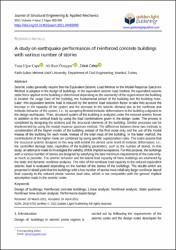| dc.contributor.author | Çapa, Yuşa Uğur | |
| dc.contributor.author | Özuygur, Ali Ruzi | |
| dc.contributor.author | Celep, Zekai | |
| dc.date.accessioned | 2021-12-13T11:26:36Z | |
| dc.date.available | 2021-12-13T11:26:36Z | |
| dc.date.issued | 2021 | en_US |
| dc.identifier.citation | ÇAPA Yuşa Uğur, Ali Ruzi ÖZUYGUR & Zekai CELEP. "A Study on Earthquake Performances of Reinforced Concrete Buildings with Various Number of Stories". Journal of Structural Engineering & Applied Mechanics, 4.2(2021): 83-98. | en_US |
| dc.identifier.uri | https://app.trdizin.gov.tr/makale/TkRVek9EQTVPUT09/a-study-on-earthquake-performances-of-reinforced-concrete-buildings-with-various-number-of-stories | |
| dc.identifier.uri | https://hdl.handle.net/11352/3989 | |
| dc.description.abstract | Seismic codes generally require that the Equivalent Seismic Load Method or the Modal Response Spectrum
Method is adopted in the design of buildings. In the equivalent seismic load method, the equivalent seismic
static force applied to the building is determined depending on the seismicity of the region where the building
is located, the usage class of the building, the fundamental period of the building and the building mass.
Later, this equivalent seismic load is reduced by the seismic load reduction factor to take into account the
increase in the capacity of the system and the decrease in the seismic demand due to the nonlinear and
inelastic behavior of the system, i.e., by accepting limited inelastic deformations in the building subjected to
the design earthquake. Then, structural system of the building is analyzed under the reduced seismic forces
in addition to the vertical loads by using the load combinations given in the design codes. The process is
completed by designing the sections and the structural elements of the building. Similar processes can be
implemented by using the modal response spectrum method. The difference between these two methods is
consideration of the higher modes of the building instead of the first mode only and the use of the modal
masses of the building for each mode, instead of the total mass of the building. In the latter method, the
contributions of the higher mode are combined by using specific superposition rules. The codes assume that
the structural systems designed in this way will exhibit the almost same level of inelastic deformation, i.e.,
the controlled damage state, regardless of the building parameters, such as the number of stories. In this
study, an attempt is made to investigate the validity of this implicit acceptance. For this purpose, the buildings
with a various number of stories are designed by satisfying the bare minimum requirements of the code only,
as much as possible. The seismic behavior and the lateral load capacity of these buildings are examined by
the static and dynamic nonlinear analyses. The ratio of the nonlinear load capacity to the reduced equivalent
seismic load is evaluated depending on the number of the stories of the buildings. The results which are
presented in detail yield that the buildings with a low number of stories have relatively larger nonlinear lateral
load capacity-to-the reduced elastic seismic load ratio, which is not compatible with the general implicit
assumption made in the seismic codes. | en_US |
| dc.language.iso | eng | en_US |
| dc.publisher | Golden Light Publishing | en_US |
| dc.relation.isversionof | 10.31462/jseam.2021.04083098 | en_US |
| dc.rights | info:eu-repo/semantics/openAccess | en_US |
| dc.subject | Design of Buildings | en_US |
| dc.subject | Reinforced Concrete Buildings | en_US |
| dc.subject | Linear Analysis | en_US |
| dc.subject | Nonlinear Analysis | en_US |
| dc.subject | Static Pushover | en_US |
| dc.subject | Nonlinear Time-domain Analysis | en_US |
| dc.subject | Performance-based Design | en_US |
| dc.title | A Study on Earthquake Performances of Reinforced Concrete Buildings with Various Number of Stories | en_US |
| dc.type | article | en_US |
| dc.relation.journal | Journal of Structural Engineering & Applied Mechanics | en_US |
| dc.contributor.department | FSM Vakıf Üniversitesi, Mühendislik Fakültesi, İnşaat Mühendisliği Bölümü | en_US |
| dc.contributor.authorID | https://orcid.org/ 0000-0002-7622-6298 | en_US |
| dc.contributor.authorID | https://orcid.org/ 0000-0002-7145-8065 | en_US |
| dc.contributor.authorID | https://orcid.org/ 0000-0002-5246-9818 | en_US |
| dc.identifier.volume | 4 | en_US |
| dc.identifier.issue | 2 | en_US |
| dc.identifier.startpage | 83 | en_US |
| dc.identifier.endpage | 98 | en_US |
| dc.relation.publicationcategory | Makale - Uluslararası Hakemli Dergi - Kurum Öğretim Elemanı | en_US |
| dc.contributor.institutionauthor | Çapa, Yuşa Uğur | |
| dc.contributor.institutionauthor | Özuygur, Ali Ruzi | |
| dc.contributor.institutionauthor | Celep, Zekai | |



















